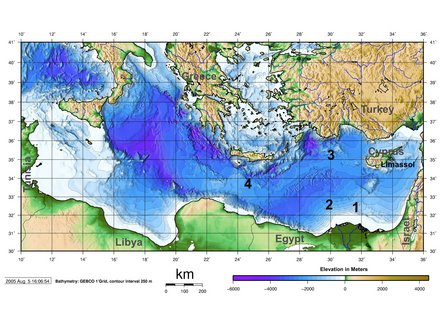Seitenpfad:
- Presse
- Pressemeldungen 2009
- 01.12.2009 European scientists at sea: A scient...
- Background: Chemosynthetic Ecosystems
Background: Chemosynthetic Ecosystems
Background: Chemosynthetic ecosystems in the Deep Eastern Mediterranean Sea
The ocean bed hosts diverse environments ranging from desert-like deep seafloor to rich oases that are present at seeps, vents, and food falls such as whales, wood or kelp. Chemosynthetic ecosystems form where chemical energy from subsurface geological or microbiological processes gets available at the seafloor. “Chemosynthesis” means that organisms can utilize chemical energy — in the form of hydrogen, methane, hydrogen sulphide and iron — to fix CO2 just as plants do, but without sunlight.
The ocean bed hosts diverse environments ranging from desert-like deep seafloor to rich oases that are present at seeps, vents, and food falls such as whales, wood or kelp. Chemosynthetic ecosystems form where chemical energy from subsurface geological or microbiological processes gets available at the seafloor. “Chemosynthesis” means that organisms can utilize chemical energy — in the form of hydrogen, methane, hydrogen sulphide and iron — to fix CO2 just as plants do, but without sunlight.
Chemosynthetic giant bacteria and tubeworms populating cold seeps of the E. Med. (Source MARUM, University Bremen)
Of the different types of chemosynthetic ecosystems known, cold seeps are now among the most geologically diverse and widely distributed systems explored to date, and new sites are still being discovered every year. Cold seep structures include pockmarks (seafloor depressions), brine lakes, and mud volcanoes as well as gas vents. They are called “cold seeps” because they are independent of magmatic heat and hence functionally different from hydrothermal ecosystems.

Cold seeps of the Eastern Mediterranean. During the expedition MSM 13 we will visit the mud volcano (1) and pockmark area (2) of the Nile Deep Sea Fan and the (3) Anaximander mountains. Another well known site with many chemosynthetic ecosystems is the Olimpi area (4). (Please click on picture for a higher resolution).
Observation of the European continental margins using in situ video and photography with deep submersibles provided evidence for a wide range of active cold-seep ecosystems associated with fluid, gas, and mud escape structures. They often emit methane and other hydrocarbons and are colonized by specific anaerobic subsurface microbiota which use hydrocarbons as an energy source and seawater sulfate to respire, thus producing high fluxes of hydrogen sulfide.
The remotely operating vehicle QUEST4000 (MARUM) and autonomous underwater vehicle ASTERx (IFREMER) in action. (Source Max Planck Institute, Bremen)
Videos from cold seeps of the E. Med.
(Source MARUM, University Bremen)
video#1: Insinc in action
video#2: Lift opening
Video #3: Net with tubeworms
Video#4: Positioning RAC2
Video#5: S-probe
Video#6 Sampling Carbonate
(Source MARUM, University Bremen)
video#1: Insinc in action
video#2: Lift opening
Video #3: Net with tubeworms
Video#4: Positioning RAC2
Video#5: S-probe
Video#6 Sampling Carbonate
Most cold seeps support highly productive communities consisting of specialized animals that can cope with elevated concentrations of chemical compounds and low oxygen levels at and below the sediment-water interface. Among the most remarkable of the fauna exploiting the abundant chemical energy of seeps are large worms and mussels storing bacterial symbionts in their tissues, which provide energy to their hosts.
The Eastern Mediterranean Sea hosts many different types of cold seeps, where intense emission of methane occurs from active mud volcanoes and along related faults. During the last decade, three major areas were the focus of multidisciplinary cruises using submersibles: the Olimpi mud volcano field, located on the Mediterranean Ridge south of Crete, the Anaximander Mountains, south of Turkey, and the seafloor of the Nile Deep Sea Fan (see map). Fresh mud flows, brines, and carbonate crusts were observed on their surfaces.
The Eastern Mediterranean Sea hosts many different types of cold seeps, where intense emission of methane occurs from active mud volcanoes and along related faults. During the last decade, three major areas were the focus of multidisciplinary cruises using submersibles: the Olimpi mud volcano field, located on the Mediterranean Ridge south of Crete, the Anaximander Mountains, south of Turkey, and the seafloor of the Nile Deep Sea Fan (see map). Fresh mud flows, brines, and carbonate crusts were observed on their surfaces.
Left: Center of the Amon mud volcano showing signs of recent eruption. Middle: Carbonate crusts form as a result of microbial methane oxidation. Right: Sulfidic muds hosting lots of bivalves. (Source MARUM, University Bremen)
During our cruise HOMER with RV Maria S. Merian (MSM13) we will visit the Nile Deep Sea Fan and the Anaximander area, to study the distribution, interconnection and functioning of the fascinating chemosynthetic ecosystems in these areas. Also, we will recover our long term experiments deposited during earlier cruises to the Eastern Mediterranean such as BIONIL in 2006 and MEDECO in 2007. These experiments have dealt with larval colonization of different substrates, and we are looking forward to seeing what types of animals have settled there. We are also looking at sunken woods, another type of chemosynthetic ecosystem, which attracts many enigmatic deep sea animals specialized on extracting energy from wood, with the help of their associated microrganisms.
Left: Sea urchins grazing on sunken wood. Middle: Wood colonisation experiment (MPI). Right: Larval settlement experiments (IFREMER, UPMC). (Source MARUM, University Bremen)
Further reading
Foucher, JP; Westbrook, GK; Boetius, A; Ceramicola, S; Dupre, S; Mascle, J; Mienert, J; Pfannkuche, O; Pierre, C; Praeg, D (2009) Structure and Drivers of Cold Seep Ecosystems, OCEANOGRAPHY 22 (1): 92-109 Sp. Iss. SI MAR
Vanreusel, A; Andersen, AC; Boetius, A; Connelly, D; Cunha, MR; Decker, C; Hilario, A; Kormas, KA; Maignien, L; Olu, K; Pachiadaki, M; Ritt, B; Rodrigues, C; Sarrazin, J; Tyler, P; Van Gaever, S; Vanneste, H (2009) Biodiversity of Cold Seep Ecosystems Along the European Margins, OCEANOGRAPHY 22 (1): 110-127 Sp. Iss. SI MAR
Jørgensen BB, Boetius A, 2007. Feast and famine – microbial life in the deep-sea bed. Nature Microbiology Reviews, 5, 770-781











